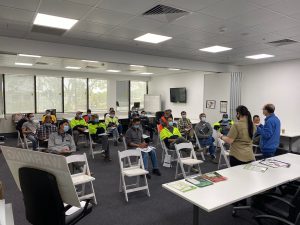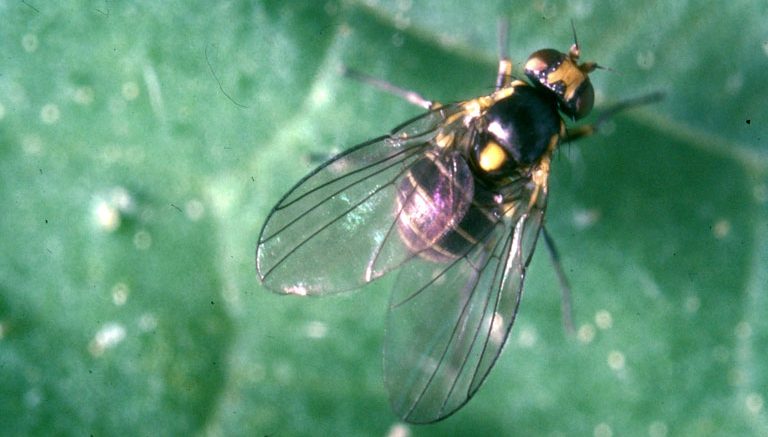Key learnings from Australia’s serpentine leafminer incursion
A highly persistent pest that affects vegetable, nursery and flower crops, serpentine leafminer (SLM) continues to be a priority for Greater Sydney vegetable growers. VegNET – New South Wales Regional Development Officer, Sylvia Jelinek provides an update on Greater Sydney’s response to the challenges posed by SLM and why Integrated Pest Management is the only effective control method.
The situation
Serpentine leafminer (SLM; Liriomyza huidobrensis) is a pest insect with the potential to significantly affect a wide range of commercial crops (vegetables, broadacre, ornamentals and non-commercial hosts). It is categorised as a high priority pest in the vegetable and potato industry biosecurity plans.
SLM was first detected in Australia in Western Sydney, NSW in October 2020 and soon after in the Fassifern Valley, Queensland in November.
The inclusion of SLM into the recently completed Hort Innovation investment, RD&E Program for control, eradication, and preparedness for vegetable leafminer (MT16004) has enabled a rapid response to these incursions in facilitating industry understanding of its significance to the vegetable industry.
The vegetable leafminer is present in a small location on the very northern tip of Far North Queensland and is being monitored closely by the Northern Australia Quarantine Strategy. It is also monitoring American serpentine leafminer, which was discovered in Western Australia in 2021.

Communicating outcomes
AUSVEG Project Officer Maddy Quirk said the previous vegetable leafminer project was a good preparation tool that armed consultants, agronomists and extension staff.
A successful webinar was held in early 2021 with all the experts and is available to watch on YouTube.
The Greater Sydney Local Land Services VegNET NSW team held a biosecurity workshop with AUSVEG and the NSW DPI under the Peri-urban Biosecurity Pilot project in March 2021. This event aimed to upskill the most affected vegetable growers in Greater Sydney with integrated pest management (IPM) techniques and monitoring tools.
VegNET NSW also held a SLM biosecurity workshop for Australian-Chinese vegetable growers at the Sydney Markets in late November 2021. This event was booked out and many resources were handed out to the attendees. Reaching out to culturally and linguistically diverse background growers is imperative to educate and pass on management strategies and teaching that less is more when it comes to spraying for SLM.

Grower lessons
Sylvia caught up with Andy Ryland, an IPM crop consultant for Integrated Pest Management Consulting. Andy has been working closely with a vegetable grower in north-west Sydney who has suffered greatly from SLM infestations. He has encouraged the grower to take chances and embrace IPM tactics.
With a consultant’s guidance, the grower has been able to turn on-farm SLM infestations around – with less pest pressure than the first year of the incursion when SLM was at its peak.
While the grower was using the recommended insecticides, he was over spraying.
This knocked out the natural beneficial parasitoid wasp population. Now, the grower is scouting their own crops for pests and learning when best to spray which has been key to controlling SLM.
The validation from an IPM consultant helped build the grower’s confidence in making appropriate decisions in SLM management. The grower has now halved their spraying while getting better control of SLM and is self-assured about using IPM on-farm. SLM isn’t totally eradicated but is being controlled using naturally occurring parasitic wasps.
Sticky traps are very useful to pick up SLM adults. A well-timed insecticide spray will give better control than applying multiple sprays. Certain weeds such as milk thistle, clover, amaranthus and fat hen are also major hosts for SLM, and they need to be monitored. Managing SLM can be difficult when neighbouring growers are not making the effort to control pest levels.
Even though SLM is usually seen in autumn through to spring, some populations were still around during Greater Sydney’s mild and wet summer. SLM is heat-sensitive, and populations can periodically be suppressed when hot days or heatwaves occur.

What we’ve learnt so far
Even though SLM has only been in Australia for 18 months, researchers have already learnt how to effectively manage it by carefully selecting recommended insecticides used appropriately with a sound IPM program.
So far, Australia has not seen SLM venture too far from coastal vegetable production areas. However, some farms in less desirable environments for SLM may have suitable on-farm micro-climates for the insect to flourish.
Shannon Mulholland is a Biosecurity Epidemiologist from the NSW DPI and has some sage advice for the vegetable industry.
“When the pest population is small, it is easy to manage – and it’s the best time to control. Don’t let it get out of control,” Shannon said.
Meanwhile, Maddy Quirk was impressed at how well industry and government agencies came together during the incursion response in late 2020, especially being in a COVID-19 world. However, she added growers needed more lessons on SLM management.
Serpentine leafminer: Research, development and extension
Many research and extension activities have been launched since the detection of SLM. These include Hort Innovation multi-industry investments Management Strategy for serpentine leafminer (Liriomyza huidobrensis) (MT20005) and RD&E Program for control, eradication and preparedness for Vegetable Leafminer – 2017-2020 (MT16004).
- MT20005 will build on the initial work undertaken in MT16004, by refining the development and validation of tools including surveillance and diagnostic protocols; predictive forecasting for SLM risk assessment and management; identifying and monitoring parasitoids; and delivering an industry communication program, including the development of industry management plans, grower guides, and industry focused workshops. For further information, please click here.
- MT16004 was developed in recognition of the extensive impact that vegetable leafminer (VLM; Liriomyza sativae) could have on the vegetable, nursery, melon and potato industries were it to move into production areas with no management plan in place. In 2019, the project underwent a variation to include RD&E activities on serpentine leafminer and American serpentine leafminer (ASLM; Liriomyza trifolii). Project partners included Cesar Australia, the University of Melbourne, Plant Health Australia, Northern Australian Quarantine Strategy (NAQS) and AUSVEG. Click here for the final report and resources.
- Other research and development in the pipeline include a project on parasitoid surveillance with Cesar Australia and improving diagnostics for exotic plant pests. NSW DPI is also looking into insecticidal resistance of SLM to determine better chemical control and resistance management options, as well as climate modelling and future predictive modelling. For comprehensive resources, visit the NSW DPI website.
Find out more
Please contact Sylvia Jelinek on 0427 086 724 or email sylvia.jelinek@lls.nsw.gov.au.
Unsure of your SLM problem? Ask a consultant, send in a sample, look into resources available or contact your VegNET Regional Development Officer or AUSVEG’s Maddy Quirk by emailing madeleine.quirk@ausveg.com.au.
VegNET 3.0 is a strategic levy investment under the Hort Innovation Vegetable Fund.
This project has been funded by Hort Innovation using the vegetable research and development levy and contributions from the Australian Government.
Project Number: VG21000
Cover image: Adult serpentine leafminer (Liriomyza huidobrensis). Image courtesy of the NSW DPI via Central Science Laboratory.

